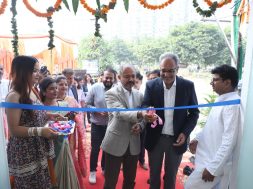
How glass can be used as a green building element?
The green building concept was introduced in the construction industry as a step towards sustainable development. It gives framework for creating an environment friendly and sustainable space. It is a holistic approach of conserving biodiversity, achieving water and energy efficiency, reusing and recycling of materials and well-being of occupants. In the same context glass also plays an important part as green building element and is an integral part of any building due to its pleasing aesthetics and functional advantages. Glass is a useful material that has such advantages like transparency, natural day-lighting, permitting a sky view and acoustic control, depending on the glazing solution used. Glass is a wholly recyclable material. Glass is beloved by architects as well as designers. Glass is a beautiful element which connects interior space to the outside environment. Studies have proven that the productivity of people working in the environmentally connected environment is more than those who are working in the enclosed environment. There can be many advantages of glass but it is important to understand how glass can be used as a green element.
Importance of glass in ‘green’ certification
LEED and Glass
LEED or Leadership in Energy and Environmental Design, is a green building certification program that recognises top-notch building strategies and practices. According to Kapil Chikodi, Head – Business Development, Glass Wall Systems, “Glass plays an important role in LEED certification and can significantly impact a building’s rating. LEED certified buildings save money and resources, and have a positive impact on the health of occupants, while promoting renewable energy.” Glass Wall Systems claims to be the pioneers in doing the first project with LEED certification for a project in Kolkata.
GRIHA and Glass
GRIHA, or Green Rating for Integrated Habitat Assessment, is a rating tool that assesses the performance of a building against certain nationally acceptable benchmarks. Developed by TERI and adopted by the Indian Government in 2007, it serves to carry out a qualitative and quantitative assessment and accordingly rate a building on its level of ‘greenness’. “Truly GRIHA certification determines the performance of glass as an element in the green building concept. This is a very important factor to guage the performance of glass,” says Chikodi.
Use of glass as a green building element
Describing about use of glass as a green building material Chikodi says, “A good solar control glass for a green building must deliver effectively on energy efficiency. The glass must take care of heat gain from direct sunlight and heat gain due to the difference in heat between the inside and outside of a building.”
Glass plays an important role in making better indoor environment believes Rajiv Balaggan, Sales-Head, Architechtural Glass India, Pilkington Glass India Ltd. He says, “Glass can play a role in accomplishing greater indoor environmental quality and when used carefully can improve energy efficiency; however a measured approach needs to be taken to ensure the building loads are not excessively increased due to relative heat gain.”
The design and placement of glass is a fundamental constituent of green architecture. It permits natural light and puts together the interior of office and residential buildings with the exterior. Natural light enhances productivity in the workplace and helps uphold a healthy environment. It is just as important that glass materials and design endorse energy efficiency, believes Balaggan.
The intent of a green building design is to curtail the demand on non-renewable resources, amplify utilisation efficiency of these resources when in use, and augment the reuse, recycling, and consumption of renewable resources.
Nowadays, a vast array of glass and glazing solutions exists to satisfy the needs of the most ambitious architects and building engineers who want to design and construct low energy or passive buildings. So, glass plays a major role in all the concepts of building, be it is a commercial or residential tower, believes Chikodi.
Presently, a total glazed building’s façades has become very common in India. According to leader in energy and environmental design (LEED), glass selection becomes a main element to contribute towards achieving a green building. “Inadequate design with ill-selected glass/glazing type may lead not only to poor day lighting in building interiors but also contribute significantly to fatigue, insomnia, seasonal affective disorder (SAD) and above all increase CO2 emission,” informs Balaggan.
Sustainable architecture is a representative of best building practices; whether it’s in term of design or execution, believes Vikram Khanna, COO – Consumer Glass, COO – Architectural Institutional Business, CMO, CIO, Asahi India Glass Ltd (AIS).
He says, “In the times of modern architecture, glass has emerged as an integral part of green buildings as a sustainable material. Glass is the only material which provides see-through property and has structural strength. A huge amount of energy savings can be achieved with the proper selection of glass. It also allows natural daylight inside the spaces which reduces the artificial lighting load drastically. Glass can be reused and recycled, reducing the need for virgin materials.”
However, he adds, “To achieve the objective of comfort inside the space, designer has to consider various aspects like area of glazing (WWR) on a particular orientation, type and configuration of glass, shading devices, performance values of the glass depending on type of building, location, and weather conditions.”
To match the material properties requirement for a tropical climate like India, AIS has a range of green products under 5 categories within the Ecosense Brand namely: Enhance (Solar Control), Exceed (Solar Control Low-E), Essence (Low-E), Edge (Solar Control and Thermal Insulation which can be used in SGU) and Excel (Double Low-E).
Saint gobain India believes, “Green building design criteria emphasizes the energy-efficient performance of fenestration materials and maximum use of natural daylight. Given this background, glass is an indispensable material for green building. It has wide range of functional benefits. Its transparency allows day lighting of the interiors and integrates the interiors with the exteriors.”
Glass is completely recyclable and non-toxic in nature. It satisfies all the ecological parameters of being the most sought after “green” building material in green buildings. Moreover it harmonises a structure with its environment.
Saint Gobain India shares few “Green” benefits of glass:
• Day lighting: The use of glass brings in lot of light that helps in giving high amount of natural day lighting instead of depending solely on artificial lighting thus reducing considerably electricity consumption.
• Blending interiors with exteriors (views): Glass facades give a spectacular view of the outside world from the cozy interiors.
• Recyclability: Glass being recyclable satisfies the important parameter of being a “Green” building material.
• Achieving energy efficiency: High performance glass helps in controlling the solar and thermal heat in the interiors and helps to maintain the temperature at its minimum best and in turn helps to tone down the air-conditioning expenses.
• Innovative application: Being very flexible building material glass helps to satisfy and capture an architect’s utmost imagination in its shape and form.
• Controls noise: Double glazed glass facades help in achieving a high degree of acoustic comfort by keeping away noise penetrating from the exteriors to the interiors thus ensuring a calmer atmosphere inside.
• Self cleaning: The future belongs to self cleaning glass which keeps itself clean on its own and brings out an ever sparkling effect.
43
Cookie Consent
We use cookies to personalize your experience. By continuing to visit this website you agree to our Terms & Conditions, Privacy Policy and Cookie Policy.









